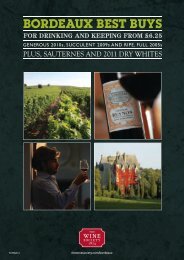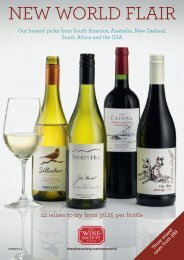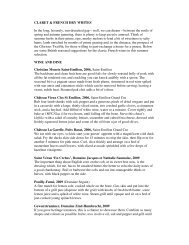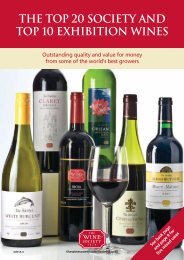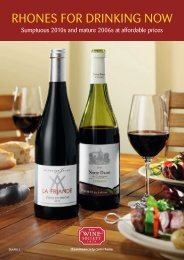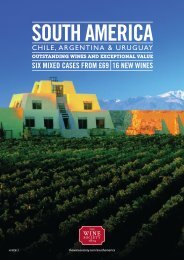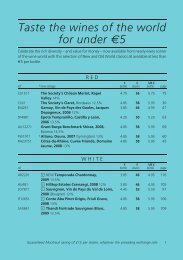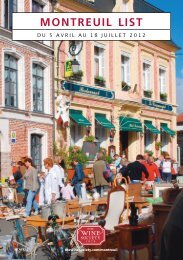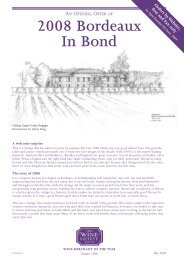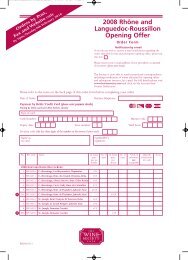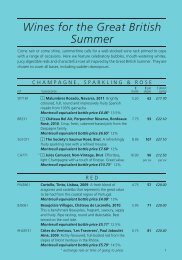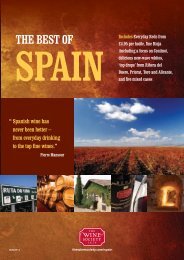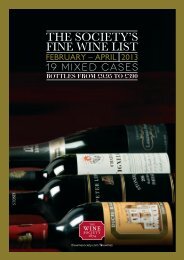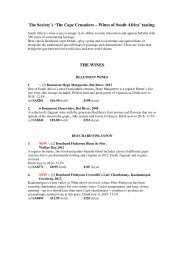ANNUAL REVIEW - The Wine Society
ANNUAL REVIEW - The Wine Society
ANNUAL REVIEW - The Wine Society
- No tags were found...
Create successful ePaper yourself
Turn your PDF publications into a flip-book with our unique Google optimized e-Paper software.
<strong>The</strong>matic offers<strong>The</strong>se are well suited to everyday occasions and seasonal needssuch as parties and gifts. Examples were: <strong>Wine</strong>s for SummerDrinking, <strong>The</strong> <strong>Society</strong> <strong>Wine</strong>s and Exhibition <strong>Wine</strong>s, Light <strong>Wine</strong>sfor Summer, <strong>Wine</strong>s for Christmas, Gift Lists, and the very popular<strong>Wine</strong> Championship offer of wines that shone in the annualcomprehensive blind tasting carried out by the buyers.Investments for the future<strong>The</strong> new warehouseFor members visiting Stevenage during the year, or passing in thetrain, the most obvious manifestation of our activities was theconstruction of the large 20-metre-high warehouse on the southeastcorner of the site.From hole in the groundto operating warehouse innine months8This time last year work was just getting under way. It wascompleted in September, on time and within budget, and hasprovided additional storage capacity of some 250,000 cases.<strong>Wine</strong>s stored off <strong>The</strong> <strong>Society</strong>’s premises will now be brought onsite, saving significant external rental costs.
<strong>The</strong> second phase of the project is due for completion in June. Itinvolves relocating some 300,000 cases within the site, theconstruction of a more streamlined bottle picking unit, and animproved despatch system. <strong>The</strong> result will be greater efficiencyand a capacity to accommodate the gradual growth of <strong>The</strong> <strong>Society</strong>.Energy savings and forest conservation<strong>The</strong> detailed attention given to energy saving during the design ofthe new warehouse delivered even better results than weexpected. This led us, with the help of the Carbon Trust, into afull energy survey of the existing buildings. <strong>The</strong> three resultingprojects will deliver a two-and-a-half-year payback on the£200,000 invested in them.Keen-eyed members will also have spotted that almost all ourpublications now carry the Forest Stewardship Council logo,reflecting our switch to paper from managed forests and recycledwood fibre.<strong>The</strong> website: www.thewinesociety.comFollowing a re-launch of the site in 2007, the focus in 2008/9was on improving the existing facilities and adding new ones.<strong>The</strong>re are now some 6,000 pages on the site with wines, winenotes, details of the various services offered by <strong>The</strong> <strong>Society</strong>, andarticles giving information on many aspects of wine and winebuying. <strong>The</strong> economics and facility of this mode ofcommunication enable so much more information both to beconveyed and to be made more easily accessible than is possiblein paper form, though, as noted earlier, we still see an importantrole being played by the printed word.New and improved facilities include: order tracking, fine wineadvice, a new home page, better navigation and search, a site tour,video content, interactive maps of tasting venues, <strong>Society</strong>Newsarticles, a wish list, paperless direct debit facilities for WWF, VCPand reserves, PDF wine notes, and press articles on <strong>The</strong> <strong>Society</strong>and its wines.A sample of images from various web pages is shown on thefollowing page.9
Some images from <strong>The</strong><strong>Society</strong>’s websiteRunning <strong>The</strong> <strong>Society</strong>Committee<strong>The</strong>re were 15 meetings of the full Committee during the year,including three half-day strategy sessions at Stevenage. <strong>The</strong> ChiefExecutive, Deputy Chairman and I also met each month toexchange views and debate topical and strategic issues.Committee meeting agendas always include the monthly financialreport and a Chief Executive’s report, accompanied by reportsfrom the heads of each department (Finance, Member Services,Marketing, Buying, Operations, and Information Systems). Nonregularitems this year included: the development of the website,two in-depth departmental reports, progress reports on the newwarehouse, plans for the subsequent site reorganisation, theFrench shop in Montreuil, <strong>The</strong> <strong>Society</strong>’s Pension Scheme, and theimpact of a weakening pound on pricing policy.<strong>The</strong> five Subcommittees, each chaired by a different member ofthe Committee, held a further 19 meetings in total. <strong>The</strong>se nonexecutiveSubcommittees discuss issues in more depth.At the 2008 AGM Stephen Bourne, the Chief Executive ofCambridge University Press, was elected to the Committeefollowing the retirement of John Cruse. Since then Warren10
Leaming, a senior compliance officer, and Guy de Froment, aVice-Chairman of an Investment Management firm, have been cooptedon to the Committee.Executives and staff<strong>The</strong> average number of full-time equivalent staff during the yearwas 199. <strong>The</strong>y report to the six Executives, who in turn report tothe Chief Executive.More challenging times bring more challenging jobs and it is agreat pleasure to be able to report that the issues arising weretackled energetically and resourcefully by all.I would like to mention Richard Shorrocks, our Head of Finance,who not only ran the finance function during the year but alsoled the energy conservation initiatives and oversaw the planningaspects associated with the new warehouse.And three long-serving members of staff retired: Ron Bracey, oneof our cellar team leaders, after 42 years (featured in theNovember news), Michael O’Shea the site maintenance engineerafter 32 years, and David Timperley one of our delivery drivers atthe Warrington depot, after 20 years.Richard ShorrocksMichael O’SheaDavid TimperleyMembersWe could not repeat the successful 2007 Summer Open Daybecause the building contractors were on the site, but we planone for 2009 when there will be an opportunity to inspect thenew warehouse and the new bottle picking and despatch areas.We did, however, meet members at tastings and at the AGM, aswell as at specially convened members’ meetings.A varied range of tastings was held throughout the country, thelocations of which can be seen from the map on the website.11
Many of these tastings are attended by our suppliers, who greatlyappreciate the opportunity to meet and talk with members, asillustrated by the following extract from a letter received inFebruary 2009.I knew by experience that London was by far the best place in the world tomeet the greatest number of wine connoisseurs. It once more proved true. Ithoroughly enjoyed the audience [at a <strong>Society</strong> tasting] and the settingwas just wonderful.Paul Pontallier, General Director Château MargauxMembers’ meetings, attended by a selection of Committeemembers and management, provide the Committee with regularfeedback on all aspects of <strong>The</strong> <strong>Society</strong>’s affairs. <strong>The</strong>se supplementinformation from more formal focus groups and surveys.One question we are always keen to explore is the extent towhich members relate to <strong>The</strong> <strong>Society</strong> as a mutual, sharing a senseof ownership and belonging, rather than just as a favouredsupplier. We find, on average, that at the beginning of a meetingthe split is about 50:50, but by the end it is at least 80:20!Encouragingly, the change stems more from the comments ofmembers present than from what we say.<strong>The</strong> other general observation, which often surprises thosepresent, is how differently members use <strong>The</strong> <strong>Society</strong>: some forfine wines or everyday wines only, some use only the Lists, othersonly the Offers, some use only the web, and so on.Sign offThis report is my 17th and last as your Chairman, as I will bestepping down at the AGM in June prior to retiring from theCommittee, under the age rule, in 2010. I joined <strong>The</strong> <strong>Society</strong> in1965, was elected to the Committee in 1973, became Treasurer in1976, and Chairman in 1992.Much has changed since 1973/74 when <strong>The</strong> <strong>Society</strong> owned noland or buildings, had an overdraft of £2.5m (in today’s pounds),offered a much narrower range of wines and services, andreceived most of its orders by post.12
It has been a great privilege to have worked with five ChiefExecutives (Desmond Moseley, Barry Sutton, Ian Ronald, JohnPearmund, and Oliver Johnson), 25 Elected Committee membersand 37 Committee co-optees, the Heads of Departments andseveral hundred members of staff, all dedicated to and caringabout <strong>The</strong> <strong>Society</strong>: a true team effort. I also owe particular thanksto my two predecessors, Edmund Penning-Rowsell andChristopher Bradshaw, whose dedication to <strong>The</strong> <strong>Society</strong> wasinspirational and from whom I learned so much, and to JohnCruse, the former Deputy Chairman, with whom I worked for 14years as a fellow officer and for 26 years in total.<strong>The</strong> <strong>Society</strong> owes so much to those who laid such strongfoundations in its earliest days, and I often think with someaffection of Mr Robert Brudenell Carter, one of the three foundersof <strong>The</strong> <strong>Society</strong>. He was a distinguished ophthalmic surgeon, aleader writer for <strong>The</strong> Times, and a fellow of <strong>The</strong> Medical <strong>Society</strong> ofLondon, the coal cellar of which housed <strong>The</strong> <strong>Society</strong>’s first winestocks (no doubt thanks to his connection). He was Treasurer ofthe <strong>Society</strong> from 1874 to 1895, and Chairman from 1895 to1915. An interesting insight into Victorian attitudes comes fromthe fact that his 23-inch obituary in <strong>The</strong> Times in 1918 didn’t evenmention his central involvement in <strong>The</strong> <strong>Wine</strong> <strong>Society</strong>!It is thanks to Mr Brudenell Carter’s account of the origins of <strong>The</strong><strong>Society</strong>, first published in a 1913 List, that we have such a clearpicture of our early history. Only a minority of members willhave seen this, so we are distributing it, along with the originalstatement of the ‘Object of <strong>The</strong> <strong>Society</strong>’ and a Bateman cartoon onthe pleasures of wine, in a leaflet accompanying this AnnualReview.<strong>The</strong> greatest pleasure of the job has been getting to know somany members through meetings, tastings, AGMs, andcorrespondence. I have signed over 150,000 individual welcomeletters, corresponded with some 1,500 members, and I haveenjoyed enormously discovering just how congenial andsupportive our membership is.Thank you for that support and for your encouragement.RAY BOWDEN Chairman13
Finance ReportOverview2008 presented a number of significant challenges for the wineindustry. Most significant was the further depreciation of sterlingagainst the euro and the US dollar: the currencies in which almostall our wine purchases are made. Over the past 18 months or so,sterling has fallen by about 30% against both these currencies. Wehedge our forward purchase commitments in an effort to reducethe exposure to unknown currency variations but, during theyear, the cost of the wine we purchased increased significantly. Atthe same time we faced above-inflation rises in duty on winesand spirits.As a consequence, and in order to continue to offer to membersthe quality and range of wines they expect from <strong>The</strong> <strong>Society</strong>, wehad to increase prices. <strong>The</strong> fall in the value of sterling was sparkedby turmoil in world financial markets and the recognition that theUK was entering a period of recession. <strong>The</strong> dual impact of thesefactors meant that the volume of wine purchased by memberswas slightly down on the previous year, though average spend permember was slightly up.Financial Reporting Standard 5 (FRS5) requires that the sale ofwine is recognised in the financial statements of <strong>The</strong> <strong>Society</strong> onlywhen it is ready for delivery to members. <strong>The</strong>refore, in any year,our financial statements include not only the sale of day-to-daywine for immediate delivery, but also those wines originally ‘sold’to members en primeur and ready for delivery during the year. <strong>The</strong>results for 2008/9 therefore include not only regular sales tomembers but also the results of the highly acclaimed 2005 enprimeur vintage, making year-on-year comparisons difficult. Afurther complication arises because 2008/9 was a 53 weekperiod, compared to a 52 week period in the previous year.Where relevant, comparative figures in this Finance Report havebeen adjusted for this additional week in arriving at year-on-yearmovements.14
Profit and Loss accountTurnover for the year was £77.7m, 21% ahead of the prior year,largely reflecting the take-up by members of the 2005 vintage.Gross profit was £13.5m. <strong>The</strong> gross profit margin fell from 19%last year to 17%, partly as a result of a change in the mix of salesto members and partly due to the higher sterling cost of thewines we bought.Administrative expenses were 9% ahead of last year, partly due tohigher depreciation, reflecting the increase in fixed assets, andpartly due to higher staff costs, reflecting a higher headcount.However, the bulk of the increase related to establishment costsincluding outside storage, insurance and rent and rates. <strong>The</strong>amount included for rates was particularly high compared to theprior year as a consequence of a reassessment this year and arelease of a provision in the accounts for 2007/8.<strong>The</strong> figure for “Other income and charges” at £0.35m was muchreduced compared to the prior year principally because bankinterest receivable fell as we used our cash balances, built up overa number of years, in the building and fitting out of the newwarehouse (see Note 4 to the financial statements).Dividends and taxation<strong>The</strong> Committee declared a dividend of 8% and this wastransferred to the accumulated profit and loss account. <strong>The</strong> <strong>Society</strong>made a profit after tax of £1.7m (2007/8 £1.8m) and a retainedprofit of £0.6m (2007/8 £0.75m).Balance sheet<strong>The</strong> balance sheet shows a number of significant changescompared to the prior year reflecting ordinary movements in thebusiness, the building and fit-out of the new warehouse andfactors relating to accounting for the 2005 vintage under FRS5.Work on warehouse 4 was completed in the year and £4.3m wasadded to fixed assets, including £3.2m for construction worksand £1.1m for fittings and equipment. Other additions to fixedassets during the year included £0.2m on computer equipmentand £0.2m on energy saving initiatives, taking total additions to£4.8m (see Note 7 to the financial statements).15
<strong>The</strong> work on the warehouse was paid for out of cash. Cash wasalso used to finance the purchase of additional stocks and inreducing creditors. Consequently total cash and deposits fell from£10.2m in 2008 to £1.8m at 30 January 2009. <strong>The</strong> sitereorganisation is estimated to cost £1.2m, of which we hadcommitted to £0.7m at the balance sheet date.Other significant movements in the balance sheet are largelyattributable to accounting for the 2005 vintage, as amounts whichwere previously held in prepayments and accrued income, stock,and in accruals and deferred income were unwound and the salesto members were recognised.Pensions<strong>The</strong>re were no material changes in either the defined benefitpension scheme (DB Scheme) or the defined contribution scheme(DC Scheme) during the year. However, we adopted theAmendment to FRS17 which has had an effect on the way inwhich some of the elements of the DB Scheme are valued. <strong>The</strong><strong>Society</strong> has chosen not to restate the corresponding amounts forthe previous period, shown in note 12 to the financial statements,as the effect is immaterial.During the year a triennial actuarial valuation of the DB Schemewas carried out by the Scheme Actuary. This reported a deficit asat 1 February 2008 of £2.3m. With the fall of equity marketssince then, that deficit would be significantly higher if assessedtoday. Agreement has been reached between the Trustees of thePension Scheme and <strong>The</strong> <strong>Society</strong> to make good the £2.3m deficitover a period of years in accordance with pension legislation.As a consequence, <strong>The</strong> <strong>Society</strong> made an additional contribution of£0.45m to the DB Scheme just prior to the year end.Consistent with the prior year, <strong>The</strong> <strong>Society</strong> contributed 17.5% ofpensionable salaries to the DB Scheme, while memberscontributed 6%. <strong>The</strong> <strong>Society</strong> also contributed £60,000 to the DCScheme in the course of the year (2007/8 £45,000).SARAH EVANS Deputy Chairman16
<strong>Wine</strong> Buyers’ ReportTwo handicaps have been imposed on wine drinkers during thelast year or so, both unwelcome at a time of worldwide recession.<strong>The</strong> first is the devaluation of sterling by about 30% against thecurrencies in which we buy most of our wine, the euro and theUS dollar (the latter includesSouth America). Secondly, thesteady increases in excise duty,which will increase tax by 2%above the rate of inflation for thenext four years.<strong>The</strong> Marqués de Arínzanobarrel cellar at Chivite<strong>Wine</strong>ry in NavarraYour buyers have been negotiatinghard with suppliers, many ofwhom are making special effortsto keep custom in the muchvaluedUK market, even thoughthey can often get better priceselsewhere. But at the ‘business’ end of wine producing, priceshave increased little over the past decade at the cellar door, andgrowers have little room to manoeuvre unless they make winethat is frankly not worth drinking. <strong>The</strong>re will be some very dismalwines indeed being sold in the UK from outlets that lower theirstandards to the floor. <strong>The</strong> purpose of wine is to give pleasure, so<strong>The</strong> <strong>Wine</strong> <strong>Society</strong> will not lower its quality standards, though wewill look for genuine value for money where it can be found.Three areas that look particularly attractive for value this comingyear are Chile, regional Spain (outside Rioja) and the South ofFrance, particularly Languedoc and Roussillon, but there areexcellent buys to be found in all wine regions as buyers’ regionalcomments suggest below.SEBASTIAN PAYNE MWAlsaceJohnny Hugel celebrated his 60th vintage in 2008 and, although Ihave tasted little, the indications are very promising. In the17
meantime, Johnny’s 59th vintage (2007) is exceptional across allstyles and for every grape variety. An offer of the best of these willbe mailed in July. For those less patient, our own-labelwines are all currently 2007s and are excellent, and nowinclude an Exhibition Gewurztraminer from Hugel.Jean Hugel celebrated his60th vintage in 2008Alsace wines keep extremely well, as those who boughtRolly-Gassmann’s 1990 riesling from the Christmas Listcan testify. Among older vintages, 1998s are now at theirbest, as are those from 2000. <strong>The</strong> higher acidity of 2001and 2002 means these needed longer to come roundand are not yet at their peak. <strong>The</strong> 2005s, bathed insunlight, are glorious and most already give muchpleasure, but my wine of the moment is a riesling fromthe slightly forgotten 2004 vintage. It is Josmeyer’s lesPierrets, the elder brother of the Exhibition Riesling which theymake for us.MARCEL ORFORD-WILLIAMSArgentina2008 is very mixed. Despite extremely difficult weather somesurprisingly attractive wines have been produced. InMendoza, a year’s annual rainfall, 220mm, fell in Marchand was followed by a frost on 17th April. Somevineyards were harvested before the rain and these havemade lovely wines. Only those producers whorigorously sorted the good from the bad have madeacceptable wines. Dominio del Plata, which producesour own-label wine, is an example. Owner andwinemaker Susana Balbo offered some excellent vats ofmalbec from which we blended <strong>The</strong> <strong>Society</strong>’s Malbec,which has turned out exceptionally well.Susana Balbo of Dominio delTOBY MORRHALLPlata makes <strong>The</strong> <strong>Society</strong>’sArgentine MalbecAustralia18South Australia – despite a record heat-wave at vintage time,2008 was a relatively mild season, suiting white grapes. <strong>The</strong> realstandout on my trip in November was Clare Valley riesling:
aromatically intense, harmonious and, in thewords of Jeffrey Grosset, ‘having the edge’.<strong>The</strong> current List also covers McLaren Vale andBarossa reds from the brilliant 2006 vintage,which are excellent now.Jeff Grosset: the king ofClare Valley rieslingWestern Australia – 2005 cabernet-merlotsare delicious to drink now and we highlyrecommend Margaret River chardonnay fromthe cool 2006 vintage. Leeuwin’s 2006 willgo down as one of the estate’s best.Victoria – the effects of the devastating bushfires earlier this yearwill be felt by inhabitants for a long time. One small blessing isthat, while vineyards were damaged in the Yarra Valley, themajority of the state’s plantings survived. <strong>The</strong> fires came within20km of Tahbilk’s old vineyards and winemaker Alister Purbrick isnow facing the prospect of smoke-tainted grapes.PIERRE MANSOURAustriaWilli Bründlmayer sets the benchmark for Austrian fine wine. Hemakes our Exhibition Grüner Veltliner, and we have featured arange of his wines over the year. Many members will have methim at our <strong>Wine</strong> Fair tasting in May and understood why he isone of our favoured Austrian producers. Keep an eye out for moreof his wines over the coming year.JOANNA LOCKE MWBeaujolais<strong>The</strong> question of What is Beaujolais? is presently exercising theminds of many growers in this picturesque part of France.Plummeting sales of Nouveau have removed a valuable safetycushion and led to failed businesses and vanishing vineyards. Yetthere are also plenty of growers who, spurred on by the excellent2005 vintage, are making some of the best wines this region hasever produced, though admittedly in a style that might baffletraditional customers.19
<strong>The</strong> cru system does not exist for nothing, and as quality rises, thedifferences between the crus become more marked. FredericBurrier of Beauregard and Guillaume de Castelnau of Louis Jadotboth make outstanding Moulin-à-Vent. As a result of their efforts,it is likely that some of the best vineyards will get premier cru status.<strong>The</strong> 2005 vintage has certainly left its mark and the wines todayare getting better and better. Louis Jadot’s single-vineyard Moulinà-Ventsare outstanding in this vintage and offer fantastic value.2006 was almost as good. 2007 is the vintage of the moment:more classic, fruitier and hugely enjoyable. All three <strong>Society</strong> ownlabels are from 2007 and are strongly recommended.M O-W20BordeauxAs this report goes to print, we have yet to make comprehensivetastings of 2008 Clarets. It was a late vintage with most of thebetter growths picking in the October sunshine. <strong>The</strong> quality of theyear was made by good autumn weather from mid-Septemberonwards. August and early September had been drab and damp, asholidaymakers may remember, though July was dry and fine.<strong>The</strong>re will be considerable disparity between well-placedvineyards and growers who work hard in the vineyard, and thoseless favoured whose grapes ripen later and those who do notprune hard and take care of their vines. <strong>The</strong> best wines will haveattractive sweet fruit and fat combined with a certain fresh acidityand tannin. <strong>The</strong>re are certain similarities with the late vintagesending in 8: 1998, 1988 and 1978, although enormous progresshas been made in vineyard management in the past 30 years.Prices of more famous classed growths have risen inexorably inrecent years, but we are seeing that the recession is forcing 2008prices down to more reasonable levels.We already know that 2008 is a very good year for dry whites, aswas 2007, though the crop is 30% smaller. <strong>The</strong> quantity ofSauternes will be tiny in 2008, so it was lucky for growers thatthe 2007s were so good.Although I believe the recession should bring a welcomecorrection in pricing classed growths, we should remember thatthe prices of Claret for more modest appellations have remained
pretty static for years. We have found some outstanding buys fromhigh achievers in the vineyards of the Côtes (Blaye, Bourg, Franc,Castillon, etc.) and many of these wines have the advantage ofbeing ready to drink earlier than classed growths. 2006, 2005,2004 and 2003 are all looking good.2004 classed-growth Clarets are progressing well, with fine aromaand balance, and look good value. <strong>The</strong> hot 2003 vintage wines aresweet and rich though they have less finesse. 2002, 2001 andeven the very fine 2000 vintage need further keeping. 1999 isperfect now. 1998 and many 1995 Clarets still seem young, butthe classic 1996s are starting to show very well. 1997s should bedrunk up and 1990s and 1989s should both be delicious but norush.Sauternes has enjoyed a wonderful serious of vintages. 2001 isoutstanding, but 2005 and 2007 will be very fine and 2003exceptionally rich.SPBurgundyWe reserve judgement of the 2008 until after the spring, whenthe malolactic fermentation is finished.In 2007, despite a year of varied weather and a harvest that beganvery early at the end of August, the wines are classic in style. Byclassic, I mean a year when ripeness is achieved at moderate levelsof alcohol, 12–13%, and where aromas are intense and lively.2007 has produced fresh, mineral white wines in the style of2004 but with more concentration. Most red wines have a similarfreshness to them, with pure pinot aromas. Yet this would not beBurgundy if there were not a few exceptions. Some red-wineproducers whose vineyards were healthy waited for the pinot toripen further and made quite round and succulent wines. Suchwas the case for Denis Bachelet, Jean-Marie Fourrier and Jean-Marc Vincent. <strong>The</strong> wines of the Mâconnais are particularlysuccessful: the combination of a warm region and a cooler yearproduced ripe wines but with a welcome freshness.For red wines, the ripe and succulent 2000 vintage has beendrinking well for a number of years, but the lighter and21
Jean Grivot: ‘outstanding2003s’beautifully fragrant 2001 has begun to sweeten and soften uprecently. <strong>The</strong> 2003s have turned out muchbetter than expected and most are drinkingwell now. Jean Grivot’s 2003s are sensational;some of the very best of the vintage. <strong>The</strong>y arerich and supported by powerful butcontrolled tannins and may behave like thevery ripe 1949s, the best of which are stilldelicious now. Most 2004s need a year or soto bloom, while the perfect 2005s are so wellbalanced that the more modest wines can beenjoyed now. Most white wines from all butthe most backward producers are drinkablethree or four years from the vintage.TMChampagne‘<strong>The</strong>re’s ever a slip…’ Not so long ago, the fears in Champagnewere about shortages. <strong>The</strong> plans for extending the area ofproduction go ahead but with falling sales some readjustmentswill have to be made. Quality, though, is at an all-time highthanks to a run of very good vintages and some well-groundedpolicies from the best houses.If 1996 remains a textbook vintage, there is growing pleasure tobe had from 1998, now coming into its own. As in Burgundy,2002 is a very good vintage for Champagne and so was 2000,with its profile of seduction and charm. Pol Roger and Bollingerare releasing their 2000s this year and both will be offered by <strong>The</strong><strong>Society</strong>.<strong>The</strong>re is of course more to fizz than Champagne and mentionmust be made of Gratien & Meyer in Saumur and Antech inLimoux, which have both responded brilliantly with supportduring the currency devaluation. Both Crémant de Loire andLimoux are outstanding this year.M O-W22
Right:Vines and cacti of LimariValley, ChileChile<strong>The</strong> 2008 vintage turned out well in Chile. After one of thecoldest and driest winters for 40 years, spring continued in thesame fashion, with frost in Casablanca on the 7th and 18thOctober, but March and April were a little warmer than usual.Each year, Chilean producers introduce new varieties or pioneernew regions. This year we have shipped our first sauvignon gris,the pink-skinned, slightly melon-flavoured variant of sauvignonblanc, and our first pinotnoir rosado. Limarí isbecoming the region forchardonnay which istauter and more mineralthan examples fromelsewhere. <strong>The</strong> Maycaswines are excellent.<strong>The</strong> new El Polilla rangeoffers excellent value for money. <strong>The</strong> wines are also made fromorganically grown grapes and are certified to have been made by asocially responsible company. <strong>The</strong> documentation was checked bydifferent administrations in at least three countries and held upthe shipment, but the wines are here and are worth the wait!TMEngland<strong>The</strong> 2007 English whites and rosés that we are currently offeringfrom Three Choirs vineyard in Newent, Gloucester, are ofexcellent quality. After bumper volumes in 2006, production fromEnglish vineyards in the past two vintages has dropped, but thequality of the wines remains remarkably high and keenly priced.Mike Roberts in Sussex continues to produce award-winningwhite and rosé sparkling wines. Demand for wine from his 30-acre Ridgeview Estate is now so strong that he buys in grapesproduced under his control from other vineyards in Sussex andKent.MARK BUCKENHAM23
Germany2008 is a vintage that has mostly yielded flavourful Kabinettwines with concentrated fruit and racy acidity; these are piquantwines that vastly exceed the expectations we had for them duringa wet September and early October. <strong>The</strong>re are only smallquantities of Spätlesen and Auslesen.Luckily, <strong>The</strong> <strong>Society</strong> and its members bought plenty of the moreabundant and utterly delicious 2007 vintage last year. Many of theestate wines will go on improving in bottle, despite their lowalcohol, for 10–20 years. We have small quantities of wines fromearlier vintages like 2005 to be offered this year which will showhow well riesling ages.SPHungaryHungary has had a tough time economically recently but its wineindustry is in good shape. Membership of euroland has broughtits challenges, most recently for exports, but it has also broughtenormous benefits. That, coupled with a fine autumn whichseems to have turned an expected sow’s ear into a silk purse,makes this a good time to buy Hungarian wine.<strong>The</strong> everyday wines offer fresh, aromatic flavours and are modestin alcohol and price. 2008 could be a great year for the fine sweetwines of Tokaji and we will continue to offer the best from thisrejuvenated region.We have tasted some superb reds and look forward to introducingthese when the exchange rate is more favourable.JL24ItalyIn a recent offer celebrating the 2005 vintage, I said that all thegreat wine regions of the world had made exceptional wine thatyear except Italy. As with all generalisations, there are some notedexceptions that prove the rule. Barolo and Barbaresco can be verygood indeed in 2005; Sassicaia is outstanding, escaping the rainthat fell in Chianti Classico; Sardinian reds were good, too.
2004, however, was a great year in many regions. Brunello diMontalcino, released early this year, is exceptional, as were theChianti Classico Riservas and great wines of Piedmont.Allegrini’s Amarone and La Poja are wonderful. 2004 hassimilarities, in terms of balance and ageworthiness, with1999 in those regions, whose wines are now perfect. 2006is looking promising for Chianti Classico and several wineswill appear in the List for the first time this year.More recently, 2007 was an exceptionally hot, dry vintageproducing ripe, rich reds but noticeably finer than theprevious very hot year, 2003. 2008 also looks goodthroughout Italy but is particularly successful in the south.Franco Allegrini: superbAmarone in VenetoCurrently, good whites come from Barberani’s Orvieto andPallavicini’s Frascati. For good-value reds, choose 2006 Barbera,2004 Copertino and <strong>The</strong> <strong>Society</strong>’s Montepulciano.SPLanguedoc & RoussillonA lax approach to viticulture remains all too prevalent in manycircles in the south of France and was definitely the wrong optionin 2008. Most vineyards suffered from rot and mildew and thesouth was no exception. Indeed, many growers here are unusedto such things, took no precautions, and saw their crops wipedout. Conscientious growers, though, are rarely caught out.Holidays were cancelled and growers will never have worked ashard as they did to bring in the 2008 vintage. Some wereunlucky: Faugères, for example, was hit by hail, which greatlyreduced the size of the crop. However, some parts of the Midi sawno rain at all and drought was the problem. A perfect Indiansummer saved the harvest. <strong>The</strong> first of the 2008 whites and pinksare delicious and easily as good as in 2007. 2008 reds are likelyto be good too, but in the meantime, the 2007 reds, as in theRhône valley, are outstanding. <strong>The</strong> wine of the moment is therecently launched <strong>Society</strong> Corbières from the 2007 vintage.M O-W25
<strong>The</strong> 2007 harvest in theLoire: good for sauvignonand fruity, forward redsLoire<strong>The</strong> Loire has done it again. Against all theodds, our early tastings suggest a good 2008vintage, especially for sauvignon blanc. <strong>The</strong>wines have wonderful fresh acidity but withlovely balancing fruit. <strong>The</strong> reds are deliciouslyforward and fruity.<strong>The</strong> Loire has benefited from a run of goodvintages, and this year we will be offeringwines from the past seven:2002: a fine, elegant, classically styled vintage, with wonderfulharmony and balance. Jacques Pareuil’s Saumur blanc is a snip,even at today’s exchange rate.2003: delicious, ripe dessert wines; full-bodied, atypically ripe,sweet-fruited reds.2004: a classic vintage, with Muscadets particularly fine. TryCuvée Centenaire from Chéreau-Carré.2005: even better for reds than 2003, with succulent ripe fruitand a little more acidity; a fine, riper vintage for whites,producing some excellent top-end sauvignons which are lovelynow. We bought more of the excellent Pouilly-Fumé fromChâteau de Tracy.2006: another ripe sauvignon vintage, where the top winescombine wonderful almost peachy fruit with fine acidity andtypically modest alcohol. Thierry Merlin Cherrier’s ChêneMarchand – available in bottle or magnum – is wonderfullyseductive now but will keep, too.2007: unexpectedly good for sauvignon and fruity, forward reds.<strong>The</strong> sauvignons have lovely fresh acidity and even the ‘little’ wineswill drink well into this year, as will the very good Muscadetsfrom Vinet and Chéreau-Carré.2008: the joys of an Indian summer: ripe-tasting but freshsauvignon blanc and Vouvray; charming, fruit-driven reds.JL26
Right:Dog Point vineyards inMarlborough, New ZealandNew ZealandMembers are buying more New Zealand wine than before – areflection of the quality and pleasure that these wines bring – and2008 was the biggest harvest ever. This put a great deal ofpressure on wineries, especially in Marlborough. <strong>The</strong> qualitydrivengrowers with their own winemaking equipment, whowere prepared to select only the ripest sauvignon, made lovelywines. Our tastings havebeen extensive to ensure ourList reflects the bestsauvignons of the vintage,avoiding the many diluteexamples which are aninevitable consequence ofsuch high yields. WitherHills, Hunters, Seresin andDog Point shine in 2008.New Zealand pinot noir continues to shake up the wine world.We are so convinced of both the quality and regional differencesacross both islands that later this year members will be able tochoose from three Exhibition pinots, from Marlborough,Martinborough and Central Otago.PMPortBy the time you receive this review, we should be puttingtogether our 2007 Vintage Port opening offer, due to be mailed inlate summer. This will be the first declared vintage since 2003,and is eagerly awaited. For current drinking, <strong>The</strong> <strong>Society</strong>’sExhibition Crusted Port, bottled in 2004, remains excellent valueand is highly recommended.MBPortugalWe were delighted at members’ response to our increased activitywith Portugal last year, and we aim to build on that. <strong>The</strong> Douro isthe leading light, producing fabulous, perfumed wines across all27
price levels – from Crasto (which we justcan’t get enough of!) to premium winesfrom both up-and-coming and famoussuppliers. <strong>The</strong> 2005s are delicious now. TryPassadouro’s for a taste of the old vines thatmake the Douro valley so special.Treading the grapes atQuinta do Crasto, PortugalFor everyday, look no further than theAlentejo – you cannot go wrong with DavidBaverstock’s delicious range at Esporão – andthe Ribatejo, where we rate Lagoalva’s easy-drinking red highly.JLRhône<strong>The</strong> most important influence in the Rhône is the Mistral, a coldand mostly dry wind that blows from the north. A year when itfails to blow is rarely good; in 2007, it blew in the spring andthen, crucially, throughout September and October, helping tocreate the greatest vintage for a generation. In 2008, whengrowers from Côte-Rôtie to the Ventoux were in a state of despair,the Mistral again returned to save the day. Early tastings arepromising, but few if any of the 2008s will ever match themajesty of 2007.<strong>The</strong> vintage of the moment is 2004, largely ignored and caughtbetween the idiosyncrasies of 2003 and power of 2005. <strong>The</strong>Châteauneufs, not far behind 2005 but less tannic, are comingout of their shells and are delicious. Syrahs from the north areelegantly poised and perfect now. <strong>The</strong> wine to drink now isChave’s Saint Joseph Offerus which was picked by all the buyersin a blind tasting in January.M O-W28South Africa<strong>The</strong>re’s never been a better time to visit this part of our List. <strong>The</strong>pound/rand rate does yo-yo a bit, but has tended to average inour favour in recent months. That, coupled with the fact that theSouth Africans, keen to build their growing market, often selltheir wines in sterling anyway, makes Cape wines exceptionally
good value. <strong>Wine</strong> quality has been getting better and better, andvalue for money is hard to beat. Rising stars such as Carl van derMerwe at Quoin Rock/Glenhurst, and Gottfried Mocke at CapeChamonix are showing what can be done with cleaned-upvineyards, well-informed but intuitive winemaking, and aninclusive attitude towards their employees. Old favourites such asMeerlust, Klein Constantia, and Kanonkop are also at the top oftheir game. Kanonkop has swept the board with awards in SouthAfrica over the last year, and we will be offering a selection oftheir wines over the next few months.JLSpainSpanish winemakers are some of the most creative and dynamicin the world. As the overall standard has increased, the lessfashionableregions, like Navarra, Calatayud and Alicante, areoffering outstanding value for money. Here we have extended ourList, and the garnachas from Cruz de Piedra and Malumbres aredelicious now. It is also a good time to buy Rioja; we offer twoexcellent vintages (2004 and 2005) – the crianzas are ready todrink but the reservas are best held for another year or so.PMEric Lemelson makesdelicious Oregon pinot noirUSAPinot noir is an increasingly important partof our range, from the delicious, fresh-tastingwines of Oregon – where we cannotrecommend Eric Lemelson’s wines highlyenough – to the generally richer, riper stylesof California. If you missed our Californiaoffer and US tasting this year, look out formore wines as the year progresses.2005 produced fabulous reds in California,with the richness and concentration one expects in most vintageshere, but with fine balance adding a touch of class, making theseour best-buy tip for 2009/10.JL29
Financial StatementsPROFIT AND LOSS ACCOUNTfor the year ended 30 January 2009Notes 2008/09 2007/08£’000 £’000Turnover 1 77,731 62,716Less: Value added tax (10,982) (9,109)66,749 53,607Cost of sales (53,224) (41,674)Gross profit 13,525 11,933Administrative expenses 2 (12,137) (10,969)Operating profit 1,388 964Other income and charges 4 354 839Profit on ordinary activities before taxation 1,742 1,803Taxation 6 (79) 6Profit after taxation 1,663 1,809MEMORANDUM OF APPROPRIATION2008/09 2007/08£’000 £’000Profit after taxation 1,663 1,809Dividends appropriated during the period 5 (1,043) (1,060)Retained Profit 620 749All operations are continuing.<strong>The</strong> accompanying accounting policies and notes form an integral part of these financialstatements.30
BALANCE SHEETas at 30 January 2009Notes 2009 2008£’000 £’000Tangible fixed assets 7 11,361 7,290Current assetsStocks 8 24,986 31,111Debtors 9 3,978 5,883Fixed term money market deposits - 9,370Cash at bank and in hand 1,811 85130,775 47,215Creditors 10 (19,972) (33,832)10,803 13,383Total fixed and current assets less creditorsexcluding pension asset 22,164 20,673Pension asset 12 52 452Net assets including pension asset 22,216 21,125Capital and reservesShare capital 13 5,696 5,480Share premium account 14 1,591 1,365Accumulated profit account 15 8,381 7,356Sales discount account 16 5,954 5,994“A” shareholders reserve fund 12 12Profit and loss account 17 582 918Shareholders’ funds 18 22,216 21,125<strong>The</strong> financial statements were approved and authorised for issue by the Committee on24th March 2009 and signed on its behalf by:A R BowdenE S EvansW D CaunceG JeffreyChairmanDeputy ChairmanSecretaryMember of the Committee<strong>The</strong> accompanying accounting policies and notes form an integral part of these financialstatements31
for the year ended 30 January 2009CASH FLOW STATEMENTNotes 2008/09 2007/08£’000 £’000Net cash (outflow)/inflow fromoperating activities 21 (4,231) 1,280Returns on investments and servicing of financeRent received 77 78Interest received 227 592Cash inflow from returns on investmentsand servicing of finance 304 670TaxationUK tax paid (60) (180)Capital expenditurePurchase of tangible fixed assets (4,807) (1,511)Cash (outflow)/inflow before management ofliquid resources and financing (8,794) 259Management of liquid resourcesMovement out of/(into) money market deposits 9,370 (1,195)FinancingShares issued to new members 452 442Shares cancelled (68) (60)Net cash inflow from financing 384 382Increase/(decrease) in cash in the year 22 960 (554)32
STATEMENT OF TOTAL RECOGNISED GAINSAND LOSSESfor the year ended 30 January 2009Notes 2008/09 2007/08£’000 £’000Profits attributable to members for the year 1,663 1,809Net actuarial loss relating to the pension scheme 12 (1,061) (543)Deferred taxation movement on pensionscheme surplus 105 (119)Total gains recognised since the lastfinancial statements 707 1,147NOTES TO THE FINANCIAL STATEMENTSfor the year ended 30 January 20091 Principal accounting policies<strong>The</strong> financial statements have been prepared under the historical costconvention and in accordance with applicable United Kingdom accountingstandards.<strong>The</strong> Committee has reviewed the principal accounting policies summarisedbelow and considers, given the requirements of Financial Reporting Standard(FRS) 5, they are the most appropriate for <strong>The</strong> <strong>Society</strong>. <strong>The</strong>se policies haveremained unchanged from the prior year with the exception of the changes tothe pension arrangements outlined below.a) TurnoverTurnover represents all sales to members and is inclusive of Customs andExcise duty and value added tax and is recognised when the goods or servicesare supplied to members.b) DepreciationDepreciation is provided on all tangible fixed assets, apart from freehold land,at rates calculated to write off the cost less estimated residual value of eachasset, on a straight-line basis, over its expected useful life, which is reviewedannually. <strong>The</strong> rates used are as follows:Freehold buildings 2.5 – 10%Equipment, furniture and fittings 10 – 50%Motor vehicles 50%Assets under constructionNo depreciationis charged on these assets33
NOTES TO THE FINANCIAL STATEMENTSfor the year ended 30 January 20091 Principal accounting policies (continued)c) StocksStocks are valued at the lower of cost and net realisable value. Cost comprisessupplier’s invoice price and, where relevant, shipping cost and excise duty. Netrealisable value is defined as the estimated selling price, net of further costs ofmarketing, selling and distribution.d) TaxationUK Corporation tax is provided at amounts expected to be paid using the taxrates and laws that have been enacted or substantially enacted by the balancesheet date. Deferred tax is recognised on all timing differences where thetransactions or events that give <strong>The</strong> <strong>Society</strong> an obligation to pay more tax inthe future, or a right to pay less tax in the future, have occurred by the balancesheet date. Deferred tax assets are recognised when it is more likely than notthat they will be recovered. Deferred tax is measured on an undiscounted basisusing rates of tax that have been enacted or substantively enacted by thebalance sheet date.e) Foreign currency translationTransactions denominated in foreign currencies are recorded at the exchangerate prevailing at the date the suppliers’ invoices are received or, if hedged, atthe forward contract rate. Monetary assets and liabilities in foreign currencieshave been expressed in sterling at the rates ruling at the balance sheet date.Any gains or losses are taken to the profit and loss account and includedwithin cost of sales.f) Pension arrangements<strong>The</strong> <strong>Society</strong> operates both a defined contribution and a defined benefitpension scheme and accounts for these in accordance with FRS 17.Defined contribution scheme:<strong>The</strong> cost of pension contributions is recognised within the profit and lossaccount in the year to which it relates.Defined benefit scheme:During the year <strong>The</strong> <strong>Society</strong> adopted “Amendment to Financial ReportingStandard (FRS) 17 Retirement Benefits”. <strong>The</strong> <strong>Society</strong> has chosen not to restatethe corresponding amounts for the previous period in note 12 as the effect isimmaterial.34Scheme assets are measured at fair values. Scheme liabilities are measured onan actuarial basis using the projected unit method and are discounted atappropriate high quality corporate bond rates. <strong>The</strong> net surplus or deficit,adjusted for deferred tax, is presented separately from other net assets on thebalance sheet. A net surplus is recognised only to the extent that it isrecoverable by <strong>The</strong> <strong>Society</strong>.
NOTES TO THE FINANCIAL STATEMENTSfor the year ended 30 January 20091 Principal accounting policies (continued)<strong>The</strong> current service cost and costs from settlements and curtailments arecharged against operating profit. Past service costs are spread over the perioduntil the benefit increases vest. Interest on the scheme liabilities and theexpected return on scheme assets are included in other financeincome/charges. Actuarial gains and losses are reported in the statement oftotal recognised gains and losses. Retirement benefits other than pensions areaccounted for in the same way.g) Lease agreementsOperating lease rentals are charged to the profit and loss account as incurred.For assets leased to third parties on operating leases, the lease rentals are takento income on a straight line basis over the term of the lease, and whereappropriate, the asset is depreciated using the straight line method.h) Financial instrumentsFinancial liabilities and equity instruments are classified according to thesubstance of the contractual arrangements entered into. An equity instrumentis any contract that evidences a residual interest in the assets of the entity afterdeducting all of its financial liabilities.Where the contractual obligations of financial instruments (including sharecapital) are equivalent to a similar debt instrument, those financial instrumentsare classed as financial liabilities. Whilst <strong>The</strong> <strong>Society</strong>’s share capital,accumulated profit and sales discount accounts, attributable to individualmembers, is payable on demand to the member’s estate on their death andthus contains debt characteristics, the overall incidence of such payments issufficiently low and the amount of such payments is sufficiently small toregard the account balances as being substantially equity in nature.35
NOTES TO THE FINANCIAL STATEMENTSfor the year ended 30 January 20092 Administrative expenses comprise: 2008/09 2007/08£’000 £’000Depreciation 736 661Fees of Committee members:- Chairman and Deputy Chairman 45 45- Other Committee members 42 43Auditor remuneration - audit services 32 27- other services 16 13Wages and salaries 4,631 4,240Social security costs 352 318Defined benefit pension current service costs 535 551Defined contribution pension costs 60 45Establishment costs 1,773 1,332Other operating costs 3,915 3,69412,137 10,969Other services supplied by the auditors related to taxation and accountancyadvice.3 Employees 2008/09 2007/08Number Number<strong>The</strong> average number of full time equivalent permanentand temporary employees during the year was: 203 1942008/09 2007/08£’000 £’000Staff costs during the year amounted to:Wages and salaries – administration 4,631 4,240Wages and salaries – transport 654 620Social security costs 403 368Defined benefit pension current service costs (note 12) 535 551Defined contribution pension costs (note 12) 60 456,283 5,824Included in administrative expenses 5,578 5,154Transport staff costs included in cost of sales 705 6706,283 5,82436
NOTES TO THE FINANCIAL STATEMENTSfor the year ended 30 January 20094 Other income and charges comprise: 2008/09 2007/08£’000 £’000Rent receivable under operating leases 77 78Bank interest receivable 227 592Other financial income (note 12) 50 169354 8395 Dividends 2008/09 2007/08£’000 £’000Transfer to accumulated profit account (note 15) 1,043 1,0606 Taxation 2008/09 2007/08£’000 £’000UK corporation tax at 21% (2007/08: 20%)based on the taxable profit for the year 63 60Total current taxation 63 60Adjustment in respect of prior year - 3Deferred taxation (note 11) 16 (69)Taxation charge/(credit) on profiton ordinary activities 79 (6)<strong>The</strong> tax assessed for the period is lower than the applicable rate of corporationtax in the UK of 21% (2007/08: 20%). <strong>The</strong> differences are explained asfollows:2008/09 2007/08£’000 £’000Profit before taxation 1,742 1,803Dividends appropriated to members (1,043) (1,060)Retained profit before taxation 699 743Retained profit before tax multiplied by the applicable rateof corporation tax in the UK of 21% (2007/08: 20%) 147 14937
NOTES TO THE FINANCIAL STATEMENTSfor the year ended 30 January 20096 Taxation (continued) 2008/09 2007/08£’000 £’000Effect of:Expenses not deductible for tax purposes 4 14Adjustment for pension contributions allowed,as opposed to charged (116) (212)Excess of depreciation and profit on disposal ofassets over capital allowances 27 110Other adjustments 1 (1)Total current taxation 63 607 Tangible fixed assetsFreehold Equipment,land and furniture Motorbuildings and fittings vehicles Total£’000 £’000 £’000 £’000Cost25 January 2008 9,168 6,654 6 15,828Additions 3,174 1,633 - 4,807Disposals - (113) - (113)30 January 2009 12,342 8,174 6 20,522Depreciation25 January 2008 3,068 5,468 2 8,538Charge for the year 247 486 3 736Disposals - (113) - (113)30 January 2009 3,315 5,841 5 9,161Net book value30 January 2009 9,027 2,333 1 11,36125 January 2008 6,100 1,186 4 7,290Freehold land and buildings include land at a cost of £2,422,000 (2008: £2,422,000)which has not been depreciated. In the prior year assets under construction, includedwithin freehold land and buildings, at a cost of £540,000 were not depreciated.38
NOTES TO THE FINANCIAL STATEMENTSfor the year ended 30 January 20098 Stocks 2009 2008£’000 £’000Stocks consist of goods purchased for resale,held as follows:In bond and overseas 23,531 29,808Duty paid 1,455 1,30324,986 31,1119 Debtors 2009 2008£’000 £’000Trade debtors 288 624Deferred tax asset (note 11) 41 57Other debtors 216 130Prepayments and accrued income 3,433 5,0723,978 5,88310 Creditors 2009 2008£’000 £’000Payments received on account from members 1,492 1,487Trade creditors 2,892 5,769Corporation tax 63 60Other taxes and social security 1,750 2,555Accruals and deferred income 13,775 23,96119,972 33,83211 Provisions for liabilities and charges 2009 2008£’000 £’000Deferred taxation at 22% (2008: 21%) isfully provided in the accounts as follows:Accelerated capital allowances (31) (47)Short term timing differences (10) (10)Included in debtors (note 9) (41) (57)<strong>The</strong> movement in the provision during the year of £16,000 was charged tothe profit and loss account. In 2007/08 £69,000 was credited to the profitand loss account (see note 6).39
NOTES TO THE FINANCIAL STATEMENTSfor the year ended 30 January 200912 Pension schemesDefined contribution schemeSince January 2007, employees have been offered membership of <strong>The</strong> <strong>Society</strong>’sstakeholder pension plan, a defined contribution scheme. During the year <strong>The</strong><strong>Society</strong> paid £60,000 (2007/08: £45,000) into the scheme. <strong>The</strong>re were nooutstanding or prepaid contributions at the balance sheet date.Defined benefit scheme<strong>The</strong> <strong>Society</strong> operates a defined benefit pension scheme for the benefit ofemployees. <strong>The</strong> scheme’s funds are administered by Trustees and areindependent of <strong>The</strong> <strong>Society</strong>’s finances. Contributions are paid to the scheme inaccordance with the recommendations of an independent actuarial adviser. <strong>The</strong>scheme is closed to new entrants.A full actuarial valuation of the scheme was carried out as at 1st February2008, which is currently being finalised. <strong>The</strong> valuation indicates a schemedeficit of £2.3m.<strong>The</strong> scheme data from the valuation was updated at 30 January 2009 by anindependent qualified actuary in accordance with FRS 17. Under FRS 17,which is calculated on a different basis to the full actuarial valuation, thescheme has a surplus of £0.07m.<strong>The</strong> major assumptions used for the actuarial valuation were:2009 2008 2007Salary growth 4.8% 5.1% 4.6%Pension increasesPre 1997 service 3.0% 3.0% 3.0%1997 to 2005 service 3.7% 3.5% 3.1%Post 2005 service 2.4% 2.3% 2.2%Discount rate 6.8% 5.9% 5.2%Price inflation 3.8% 3.6% 3.1%Life expectancy of male aged 65at the accounting date 23.0 years 22.8 years 21.0 yearsLife expectancy of male aged 65,20 years after the accounting date 26.0 years 25.9 years 22.1 years<strong>The</strong> actuarial tables used for life expectancy were Pna00 medium cohort withan underpin of 1.5% for future improvements.40
NOTES TO THE FINANCIAL STATEMENTSfor the year ended 30 January 200912 Pension scheme (continued)<strong>The</strong> expected rate of return on the scheme assets and their distributionwere:2009 2009 2008 2008 2007 2007Expected Fair value Expected Fair value Expected Fair valueReturn £’000 Return £’000 Return £’000(pa)(pa)Equities 6.5% 9,807 6.5% 10,268 6.5% 11,084Corporate Bonds 6.8% 2,476 5.9% 2,808 5.2% 774Gilts 4.5% 2,574 4.5% 3,163 4.5% 1,662Cash 2.1% 900 4.5% 1,125 5.5% 2,508AVCs 6.8% 138 5.9% 149 5.2% 15415,895 17,513 16,182<strong>The</strong> current allocation of the scheme assets isas follows:2009 2008 2007Equity instruments 62% 59% 68%Debt instruments 32% 34% 15%Other 6% 7% 17%100% 100% 100%To ascertain the assumptions for the expected long term rate of return on assets, <strong>The</strong><strong>Society</strong> considered the current level of expected returns on risk free investments(primarily Government bonds), the historical level of the risk premium associated withthe other asset classes in which the portfolio is invested and the expectations for futurereturns of each asset class.<strong>The</strong> amount recognised in the balance sheet is as follows:2009 2008 2007Fair value of scheme assets 15,895 17,513 16,182Present value of schemeliabilities (15,828) (16,941) (16,175)Surplus 67 572 7Related deferred tax liability (15) (120) (1)Net asset 52 452 641
NOTES TO THE FINANCIAL STATEMENTSfor the year ended 30 January 200912 Pension scheme (continued)During the year, contributions by <strong>The</strong> <strong>Society</strong> of £1.041m (2007/08: £1.490m) weremade to the scheme including an additional contribution of £0.45m. <strong>The</strong> contributionsduring the year were 17.5% of pensionable salary and it is expected that futurecontributions will be at a rate of 18.5% of pensionable salaries plus any additionaldeficit contributions as agreed between <strong>The</strong> <strong>Society</strong> and the Trustees of the scheme.Amount charged to operating profit:2008/09 2007/08£’000 £’000Employer’s part of current service cost 535 551Included in finance income:2008/09 2007/08£’000 £’000Expected return on scheme assets 1,059 1,021Interest on pension scheme liabilities (1,009) (852)Net credit to finance income 50 169Net amount charged to the profit and loss account 485 382Changes in the present value of the defined benefit obligation are asfollows:2008/09 2007/08£’000 £’000Opening defined benefit obligation 16,941 16,175Employer’s part of current service cost 535 551Interest cost 1,009 852Contributions from scheme members 197 191Actuarial gain (FRS 17 discount ratehigher than expected) (2,431) (491)Benefits paid (423) (337)Closing defined benefit obligation 15,828 16,94142
NOTES TO THE FINANCIAL STATEMENTSfor the year ended 30 January 200912 Pension scheme (continued)Changes in the fair value of the scheme assets are as follows:2008/09 2007/08£’000 £’000Opening fair value of scheme assets 17,513 16,182Expected return on scheme assets 1,059 1,021Actuarial loss (actual return less expected return) (3,492) (1,034)Contributions by <strong>The</strong> <strong>Society</strong> 1,041 1,490Contributions by scheme members 197 191Benefits paid (423) (337)Closing fair value of scheme assets 15,895 17,513<strong>The</strong> actual return on the scheme assets over the year was a loss of £2.433m(2007/08: loss of £0.013m). <strong>The</strong> amount recognised outside the profit andloss account in the statement of total recognised gains and losses for 2008/09is a loss of £1.061m (2007/08: loss of £0.543m). <strong>The</strong> cumulative amountrecognised outside the profit and loss account at 30 January 2009 is a loss of£4.94m.<strong>The</strong> funding position of the scheme at 30 January 2009 and the previousfour years is as follows:2009 2008 2007 2006 2005£000 £000 £000 £000 £000Fair value of schemeassets 15,895 17,513 16,182 14,082 10,509Present value of definedbenefit obligation (15,828) (16,941) (16,175) (16,013) (13,084)Scheme surplus/(deficit) 67 572 7 (1,931) (2,575)As permitted under the amended Financial Reporting Standard (FRS) 17, <strong>The</strong><strong>Society</strong> has chosen not to restate the corresponding amounts for the fair valueof the assets in the previous periods as the effect is immaterial; the assets forthese periods are stated at market value.43
NOTES TO THE FINANCIAL STATEMENTSfor the year ended 30 January 200912 Pension scheme (continued)<strong>The</strong> history of experience adjustments has been:2008/09 2007/08 2006/07 2005/06 2004/05Experience adjustments on scheme assets:Amount of actuarial (loss)/gain(£’000) (3,492) (1,034) 314 1,426 381Percentage of scheme assets (22%) (6%) 2% 10% 4%Experience adjustments onscheme liabilities:Amount of (loss)/gain (£’000) (95) - - 434 (11)Percentage of the present valueof the Scheme liabilities (1%) - - 3% (0%)13 Share capital 2009 2008£’000 £’00025 January 2008 5,480 5,270Additions 226 2215,706 5,491Cancellation of shares (10) (11)30 January 2009 5,696 5,480Representing Number Number“A” shares of £20 each 18,569 18,605“B” shares of £20 each 266,202 255,406284,771 274,01114 Share premium account 2009 2008£’000 £’00025 January 2008 1,365 1,144Share premium additions to share capital 226 22130 January 2009 1,591 1,36544
NOTES TO THE FINANCIAL STATEMENTSfor the year ended 30 January 200915 Accumulated profit account 2009 2008£’000 £’00025 January 2008 7,356 6,313Cancellation of shares (18) (17)7,338 6,296Dividends appropriated from the profitand loss account 1,043 1,06030 January 2009 8,381 7,35616 Sales discount account 2009 2008£’000 £’00025 January 2008 5,994 6,026Cancellation of shares (40) (32)30 January 2009 5,954 5,99417 Profit and loss account 2009 2008£’000 £’00025 January 2008 918 831Actuarial losses recognised (net of deferred taxation) (956) (662)Profit after taxation 1,663 1,809Dividends appropriated in the period (1,043) (1,060)30 January 2009 582 91818 Reconciliation of movement 2009 2008in shareholders’ funds £’000 £’000Retained profit for the year 620 749Dividends appropriated 1,043 1,0601,663 1,809New shares issued - nominal value 226 221- share premium 226 221Cancellation of shares (68) (60)Opening shareholders’ funds 21,125 19,596Actuarial losses recognised (net of deferred taxation) (956) (662)Closing shareholders’ funds 22,216 21,12545
NOTES TO THE FINANCIAL STATEMENTSfor the year ended 30 January 200919 Operating leasesDuring the year, <strong>The</strong> <strong>Society</strong> paid £203,000 (2007/08: £178,000) in respectof operating leases, all of which related to motor vehicles and officeequipment.At 30 January 2009 <strong>The</strong> <strong>Society</strong> had annual commitments under noncancellableoperating leases as follows which expire:2009 2008Motor Motorvehicles and vehicles andoffice officeequipment equipment£’000 £’000Within one year 107 10Between one and five years 79 163186 17320 Foreign currency purchase commitmentsAt the balance sheet date <strong>The</strong> <strong>Society</strong> had outstanding forward currencypurchase commitments amounting to£12,050,000 (2008: £8,290,000).21 Reconciliation of operating profit 2008/09 2007/08to net cash flow from operating activities £’000 £’000Operating profit 1,388 964Depreciation 736 661Decrease/(increase) in stocks 6,125 (8,390)Decrease in debtors 1,889 2,904(Decrease)/increase in creditors (13,863) 6,080Excess of employer pension contributionspaid over charge to profit (506) (939)Net cash (outflow)/inflow fromoperating activities (4,231) 1,28046
NOTES TO THE FINANCIAL STATEMENTSfor the year ended 30 January 200922 Analysis and reconciliation of net funds 2008/09 2007/08£’000 £’000Cash at bank and in hand 851 1,405Fixed term money market deposits 9,370 8,175Net funds at beginning of year 10,221 9,580Increase/(decrease) in cash in the year 960 (554)Movement in fixed term money market deposits (9,370) 1,195Change in net funds resulting from cash flows (8,410) 641Net funds at end of year 1,811 10,221Represented byCash at bank and in hand 1,811 851Fixed term money market deposits - 9,370Net funds at end of year 1,811 10,22147
COMMITTEE’S RESPONSIBILITIES<strong>The</strong> Committee is required by the Friendly and Industrial and Provident Societies Act1968 and the Industrial and Provident Societies Acts 1965 to 2002 to prepare financialstatements for each financial year which give a true and fair view of the state of affairsof <strong>The</strong> <strong>Society</strong> and of the profit or loss of <strong>The</strong> <strong>Society</strong> for that period. In preparing thosefinancial statements, it is the responsibility of the Committee to:•select suitable accounting policies and then apply them consistently;•make judgements and estimates that are reasonable and prudent;•state whether applicable accounting standards have been followed, subject to anymaterial departures disclosed and explained in the financial statements; and•prepare the financial statements on the going concern basis unless it isinappropriate to presume that <strong>The</strong> <strong>Society</strong> will continue in business.<strong>The</strong> Committee is responsible for ensuring that <strong>The</strong> <strong>Society</strong> keeps proper accountingrecords which disclose with reasonable accuracy at any time the financial position of<strong>The</strong> <strong>Society</strong> and enable it to ensure that the accounts comply with the Friendly andIndustrial and Provident Societies Act 1968 and the Industrial and Provident SocietiesActs 1965 to 2002. It also has general responsibility for taking such steps as arereasonably open to it to safeguard the assets of <strong>The</strong> <strong>Society</strong> and to prevent and detectfraud and other irregularities.In so far as the Committee is aware:•there is no relevant audit information of which <strong>The</strong> <strong>Society</strong>’s auditor is unaware;and•the Committee has taken all steps that it ought to have taken to make itself awareof any relevant audit information and to establish that the auditor is aware of thatinformation.48
REPORT OF THE INDEPENDENT AUDITORTo the Members of the International Exhibition Co-operative <strong>Wine</strong> <strong>Society</strong> Limited:We have audited the financial statements of <strong>The</strong> International Exhibition Co-operative<strong>Wine</strong> <strong>Society</strong> Limited (“<strong>The</strong> <strong>Society</strong>”) for the year ended 30 January 2009 whichcomprise the profit and loss account, the balance sheet, the cash flow statement, thestatement of total recognised gains and losses and notes 1 to 22. <strong>The</strong>se financialstatements have been prepared under the accounting policies set out therein.This report is made solely to <strong>The</strong> <strong>Society</strong>’s members, as a body, in accordance with theFriendly and Industrial and Provident Societies Act 1968 and the Industrial andProvident Societies Acts 1965 to 2002. Our audit work has been undertaken so that wemight state to <strong>The</strong> <strong>Society</strong>’s members those matters we are required to state to them inan auditor’s report and for no other purpose. To the fullest extent permitted by law, wedo not accept or assume responsibility to anyone other than <strong>The</strong> <strong>Society</strong>’s members as abody, for our audit work, for this report, or for the opinions we have formed.Respective responsibilities of <strong>The</strong> Committee and the auditor<strong>The</strong> Committee’s responsibilities for preparing the financial statements in accordancewith United Kingdom law and Accounting Standards (United Kingdom GenerallyAccepted Accounting Practice) are set out in the statement of the Committee’sresponsibilities.Our responsibility is to audit the financial statements in accordance with relevant legaland regulatory requirements and International Standards on Auditing (UK and Ireland).We report to you our opinion as to whether the financial statements give a true and fairview and are properly prepared in accordance with the Friendly and Industrial andProvident Societies Act 1968 and the Industrial and Provident Societies Acts 1965 to2002.In addition we report to you if, in our opinion, <strong>The</strong> <strong>Society</strong> has not kept properaccounting records, if we have not received all the information and explanations werequire for our audit, or if information specified by law is not disclosed.We read other information contained in the Annual Review, and consider whether it isconsistent with the audited financial statements. This other information comprises theChairman’s Report, the Finance Report and the <strong>Wine</strong> Buyers’ Reports. We consider theimplications for our report if we become aware of any apparent misstatements ormaterial inconsistencies with the financial statements. Our responsibilities do not extendto any other information.49
Basis of audit opinionWe conducted our audit in accordance with International Standards on Auditing (UKand Ireland) issued by the Auditing Practices Board. An audit includes examination, on atest basis, of evidence relevant to the amounts and disclosures in the financialstatements. It also includes an assessment of the significant estimates and judgementsmade by the Committee in the preparation of the financial statements, and of whetherthe accounting policies are appropriate to <strong>The</strong> <strong>Society</strong>’s circumstances, consistentlyapplied and adequately disclosed.We planned and performed our audit so as to obtain all the information andexplanations which we considered necessary in order to provide us with sufficientevidence to give reasonable assurance that the financial statements are free from materialmisstatement, whether caused by fraud or other irregularity or error. In forming ouropinion we also evaluated the overall adequacy of the presentation of information in thefinancial statements.OpinionIn our opinion:•the financial statements give a true and fair view, in accordance with UnitedKingdom Generally Accepted Accounting Practice, of the state of <strong>The</strong> <strong>Society</strong>’saffairs as at 30 January 2009 and of its profit for the year then ended;•the financial statements have been properly prepared in accordance with theFriendly and Industrial and Provident Societies Act 1968 and the Industrial andProvident Societies Acts 1965 to 2002; and•the information given in the Annual Review is consistent with the financialstatements.24 March 2009Grant Thornton UK LLPRegistered AuditorsChartered AccountantsLondon Thames Valley OfficeSlough50
ACCUMULATED PROFIT ACCOUNT<strong>The</strong> following table shows the amounts of Accumulated Profits to the credit of members, accordingto their share numbers, as at 30 January 2009. Profits are distributed on the combined value ofeach share and its relative accumulated profit. Such aggregate values are payable only on thedecease of a member.Years to shares Years to shares Years to sharesDecember issued £ January issued £ January issued £1874-82 1-1050 1282.56 1913 3451-3580 161.83 1968 42235-43765 58.481883 1051-1090 296.40 1914 3581-3689 157.46 1969 43766-45560 58.481884 1091-1141 288.43 1915 3690-3805 152.53 1970 45561-47675 57.711142-1176 282.82 1916 3806-3875 150.45 1971 47676-49068 56.711885 1177-1203 274.49 1917 3876-3987 148.40 1972 49069-50716 55.261204-1221 273.28 1918 3988-4077 144.98 1973 50717-53016 53.661886 1222-1234 272.01 1919 4078-4114 141.81 1974 53017-54779 53.291235-1260 270.40 1920 4115-4197 138.88 1975 54780-56495 46.171887 1261-1283 265.21 1921 4198-4399 135.95 1976 56496-57960 45.151284-1313 262.80 1922 4400-4997 133.37 1977 57961-64160 45.151888 1314-1332 259.92 1923 4998-5252 130.70 1978 64161-69632 44.061333-1350 257.23 1924 5253-5564 129.69 1979 69633-75075 42.151889 1351-1374 255.13 1925 5565-5860 127.15 1980 75076-79820 41.231375-1402 251.74 1926 5861-6230 124.81 1981 79821-83605 40.311890 1403-1454 249.92 1927 6231-6666 122.60 1982 83606-89386 38.691455-1498 247.91 1928 6667-7188 120.59 1983 89387-94154 37.141891 1499-1554 232.27 1929 7189-7712 118.60 1984 94155-98759 35.601555-1613 230.80 1930 7713-8303 116.45 1985 98760-106279 34.231892 1614-1694 228.48 1931 8304-8907 114.66 1986 106280-112690 32.871695-1732 226.03 1932 8908-9488 112.96 1987 112691-116698 31.601893 1733-1784 224.09 1933 9489-10311 111.16 1988 116699-120997 29.151785-1826 222.60 1934 10312-10807 109.78 1989 120998-128252 26.821894 1827-1860 220.54 1935 10808-11659 108.26 1990 128253-135454 24.611861-1882 217.42 1936 11660-12634 106.80 1991 135455-143358 22.461895 1883-1911 215.53 1937 12635-13808 105.52 1992 143359-151797 20.461912-1944 212.15 1938 13809-15149 104.21 1993 151798-159300 18.541896 1945-1984 205.72 1939 15150-16551 103.00 1994 159301-167394 16.691985-2024 204.35 1940 16552-17480 101.67 1995 167395-175220 14.941897 2025-2059 201.11 1941 17481-17995 100.65 1996 175221-182893 14.272060-2105 199.70 1942 17996-18055 100.65 1997 182894-191950 13.621898 2106-2140 198.49 1943 18056-18059 99.72 1998 191951-201150 10.302141-2197 196.01 1946 18060 95.60 1999 201151-212344 8.841899 2198-2282 194.32 1949 18061-18081 93.33 2000 212345-223503 8.842283-2336 192.68 1950 18082-20881 92.52 2001 223504-230168 7.211900 2337-2378 189.57 1951 20882-23954 92.32 2002 230169-236802 6.172379-2425 187.54 1952 23955-26972 91.93 2003 236803-244154 4.241901 2426-2471 186.89 1953 26973-27901 91.26 2004 244155-252150 4.002472-2517 184.44 1954 27902-28503 89.71 2005 252151-260127 3.771955 28504-29127 86.47 2006 260128-269960 3.54Years to 1956 29128-29874 84.68 2007 269961-281672 3.54January 1957 29875-30676 83.48 2008 281673-292724 3.541903 2518-2617 182.42 1958 30677-31510 82.69 2009 292725-304005 1.601904 2618-2703 177.60 1959 31511-32180 79.801905 2704-2783 175.05 1960 32181-32999 74.721906 2784-2866 172.90 1961 33000-33975 70.651907 2867-2947 172.08 1962 33976-35183 67.331908 2948-3022 170.18 1963 35184-36367 63.991909 3023-3096 169.34 1964 36368-37906 62.061910 3097-3194 168.09 1965 37907-39443 60.271911 3195-3317 166.66 1966 39444-40923 58.481912 3318-3450 165.86 1967 40924-42234 58.48Under the provisions of section 887 of the Income Tax Act, 2007, the above amounts are subject to deduction ofincome tax if they are payable to a person whose usual place of abode is not within the United Kingdom.51
GOVERNANCE AND MANAGEMENT OFTHE SOCIETY<strong>The</strong> <strong>Society</strong>’s full name is <strong>The</strong> International Exhibition Co-operative <strong>Wine</strong> <strong>Society</strong>Limited. It was founded in 1874 and from its inception has been a mutual organisation.It is governed by its Rules which, amongst other things, dictate that ‘<strong>The</strong> <strong>Society</strong>, incarrying out its objects and powers, shall have regard to co-operative principles’. <strong>The</strong><strong>Society</strong> is entirely owned by its members, each of whom holds one share.<strong>The</strong> board of <strong>The</strong> <strong>Society</strong> is known as ‘the Committee’ and it consists of up to 13members of <strong>The</strong> <strong>Society</strong>. Eight are elected by the membership; one is the ChiefExecutive, ex officio; and up to another four may be co-opted for limited periods by theeight elected members. <strong>The</strong> elected members appoint from their number the Chairmanand Deputy Chairman of <strong>The</strong> <strong>Society</strong> (known as the Officers).<strong>The</strong> Committee has responsibility to the members for the direction of the business,with day to day management in the hands of an executive team led by the ChiefExecutive.<strong>The</strong> Executive Team takes the operational decisions and leads the staff in implementingthe agreed goals and strategy. It comprises the Chief Executive and the Heads of Buying,Finance, Information Systems, Marketing, Member Services, and Operations.<strong>The</strong> Committee’s role includes discussing and deciding long term strategy, establishingpolicy, monitoring risk exposure and performance, approving the Annual Accounts andmajor capital investment projects, and appointing the Chief Executive. <strong>The</strong> Officersmaintain regular contact with the Chief Executive and the individual expertise of eachmember of the Committee is also available to the Executive Team.52
<strong>The</strong> <strong>Wine</strong> <strong>Society</strong>’s Committee May 2009Ray Bowden Retired from City career as Head of Research and investmentanalyst: age 70. Treasurer 1976 to 1992, Chairman since 1992. Member ofall Subcommittees.Sarah Evans 45: Chartered Accountant. Deputy Chairman since 2007.Chairman of Finance Subcommittee and member of all Subcommittees. Non-Executive Director of Ipswich Building <strong>Society</strong>Stephen Bourne Chief Executive of an academic publisher, aged 57. Heoffers particular experience in distribution, finance, marketing and not-forprofitorganisations.Katherine Douglas Musician and teacher: age 41. Marketing Subcommittee.Particularly interested in the views of new and younger members and <strong>The</strong><strong>Society</strong>’s communications.*Guy de Froment Vice-Chairman of an Investment Management firm.Age 59. Main interests: marketing, finance, wines of Burgundy and Italy.George Jeffrey Committee member since 1996, aged 62. Chairman of ISsub-committee, organiser of Membership contact meetings and <strong>Society</strong>representative on the committee of the <strong>Wine</strong> <strong>Society</strong> Dining Club. Particularinterests: the effective use of Information Technology in supporting businessgoals, and the wines of Italy and the New World.*Oliver Johnson Chief Executive since March 2004: age 53. Member of allSubcommittees. <strong>Wine</strong> and Spirit Trade Association: Chairman of DistanceSelling Committee. Non-Executive Director of the National Forest Company.*Warren Leaming Solicitor: age 47. Particular interest: using legalexperience to contribute to the continued stability, diversity and success of<strong>The</strong> <strong>Society</strong> for the benefit of its members.Luke Nunneley Chief Executive of a global asset management business: age46. Finance Subcommittee. Particular interests: safeguarding the character of<strong>The</strong> <strong>Society</strong> while meeting the competitive challenges of the marketplace, thewines of Bordeaux and the New World.Michael Schuster <strong>Wine</strong> lecturer and writer: age 61. <strong>Wine</strong> SubcommitteeChairman. Particular interests: the quality, range and value of <strong>The</strong> <strong>Society</strong>’swines, and communicating these aspects to members new and old, viatasting events, tasting cases, literature and the website.Mike Thompson Senior Vice President, Pharmaceutical Company: age 51.Marketing Subcommittee Chairman. Main interests: marketing, strategydevelopment, wines of Bordeaux and Alsace and Port.* Co-opted member
Registered as: <strong>The</strong> International Exhibition Co-operative<strong>Wine</strong> <strong>Society</strong> Limited, Gunnels Wood Road, Stevenage,Hertfordshire SG1 2BTEnquiries 01438 741177Orders 01438 740222Website www.thewinesociety.comAR0509



